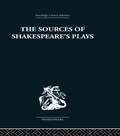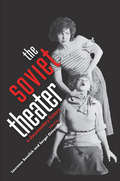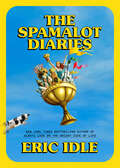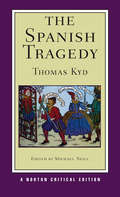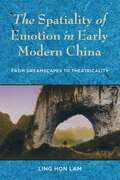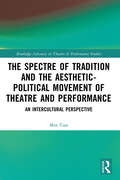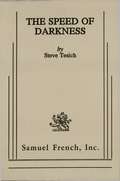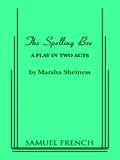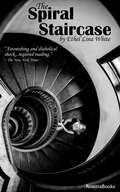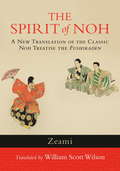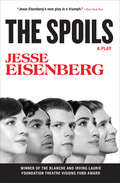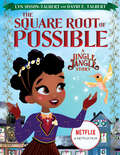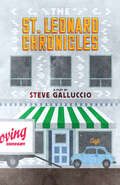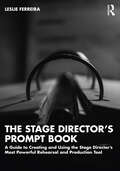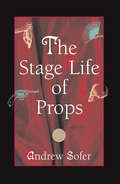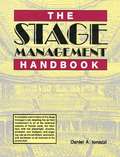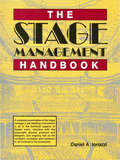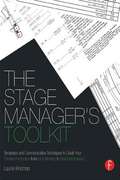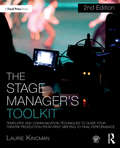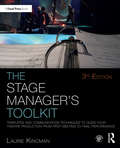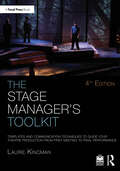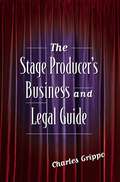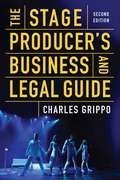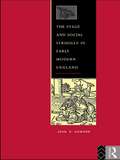- Table View
- List View
The Sources of Shakespeare's Plays
by Kenneth MuirFirst published in 1977. This book ascertains what sources Shakespeare used for the plots of his plays and discusses the use he made of them; and secondly illustrates how his general reading is woven into the texture of his work. Few Elizabethan dramatists took such pains as Shakespeare in the collection of source-material. Frequently the sources were apparently incompatible, but Shakespeare's ability to combine a chronicle play, one or two prose chronicles, two poems and a pastoral romance without any sense of incongruity, was masterly. The plays are examined in approximately chronological order and Shakespeare's developing skill becomes evident.
The Soviet Theater
by Mr Laurence Senelick Mr Sergei OstrovskyIn this monumental work, Laurence Senelick and Sergei Ostrovsky offer a panoramic history of Soviet theater from the Bolshevik Revolution to the eventual collapse of the USSR. Making use of more than eighty years' worth of archival documentation, the authors celebrate in words and pictures a vital, living art form that remained innovative and exciting, growing, adapting, and flourishing despite harsh, often illogical pressures inflicted upon its creators by a totalitarian government. It is the first comprehensive analysis of the subject ever to be published in the English language.
The Spaces of Irish Drama
by Helen Heusner LojekLojek provides extensive analysis of space in plays by living Irish playwrights, applying practical understandings of staging and the insights of geographers and spatial theorists to drama in an era increasingly aware of space.
The Spamalot Diaries
by Eric Idle&“A rollicking account of the making of [the] Broadway musical Spamalot [and] an irresistible and unfiltered ode to the art of live theater. Fans will love this tantalizing glimpse behind the curtain.&”—Publishers Weekly (starred review)From comedy legend Eric Idle, the fascinating inside story of bringing Monty Python and the Holy Grail to Broadway as the unlikely theatrical hit Spamalot On March 17, 2005, Spamalot debuted on Broadway to rapturous reviews for its star-studded creative team, including creators Eric Idle and John du Prez, director Mike Nichols, and stars Hank Azaria, David Hyde Pierce, Sara Ramirez, Tim Curry, and more. But long before the show was the toast of Broadway and the winner of three Tony Awards, it was an idea threatening to fizzle out before it could find its way into existence. Now, in The Spamalot Diaries, Eric Idle shares original journal entries and raw email exchanges—all featuring his whip-smart wit—that reveal the sometimes bumpy, always entertaining path to the show&’s unforgettable run. In the months leading up to that opening night, financial anxieties were high with a low-ceiling budget and expectations that it would take two years to break even. Collaborative disputes put decades-long friendships to the test. And the endless process of rewriting was a task as passionate as it was painstaking. Still, there&’s nothing Idle would change about that year. Except for the broken ankle. He could do without the broken ankle. Chronicling every minor mishap and triumph along the way, as well as the creative tension that drove the show to new heights, The Spamalot Diaries is an unforgettable look behind the curtain of a beloved musical and inside the wickedly entertaining mind of one of our most treasured comic performers.
The Spanish Tragedy
by Thomas KydThe freshly edited and annotated text comes with a full introduction and illustrative materials intended for student readers. The Spanish Tragedy was well known to sixteenth-century audiences, and its central elements--a play-within-a-play and a ghost bent on revenge--are widely believed to have influenced Shakespeare's Hamlet. This volume includes a generous selection of supporting materials, among them Kyd's likely sources (Virgil, Jacques Yver, and the anonymous "The Earl of Leicester Betrays His Own Servant"), Thomas Nashe's satiric criticism of Kyd, Michel de Montaigne and Francis Bacon on revenge, and "The Ballad of The Spanish Tragedy," which suggests the play's initial reception. "Criticism" is thematically organized to provide readers with a clear sense of the play's major themes. Contributors include Michael Hattaway, Jonas A. Barish, Donna B. Hamilton, G. K. Hunter, Lorna Hutson, Molly Smith, J. R. Mulryne, T. McAlindon, and Andrew Sofer. A Selected Bibliography is also included.
The Spatiality of Emotion in Early Modern China: From Dreamscapes to Theatricality
by Ling Hon LamEmotion takes place. Rather than an interior state of mind in response to the outside world, emotion per se is spatial, at turns embedding us from without, transporting us somewhere else, or putting us ahead of ourselves. In this book, Ling Hon Lam gives a deeply original account of the history of emotions in Chinese literature and culture centered on the idea of emotion as space, which the Chinese call “emotion-realm” (qingjing).Lam traces how the emotion-realm underwent significant transformations from the dreamscape to theatricality in sixteenth- to eighteenth-century China. Whereas medieval dreamscapes delivered the subject into one illusory mood after another, early modern theatricality turned the dreamer into a spectator who is no longer falling through endless oneiric layers but pausing in front of the dream. Through the lens of this genealogy of emotion-realms, Lam remaps the Chinese histories of morals, theater, and knowledge production, which converge at the emergence of sympathy, redefined as the dissonance among the dimensions of the emotion-realm pertaining to theatricality.The book challenges the conventional reading of Chinese literature as premised on interior subjectivity, examines historical changes in the spatial logic of performance through media and theater archaeologies, and ultimately uncovers the different trajectories that brought China and the West to the convergence point of theatricality marked by self-deception and mutual misreading. A major rethinking of key terms in Chinese culture from a comparative perspective, The Spatiality of Emotion in Early Modern China develops a new critical vocabulary to conceptualize history and existence.
The Spectre of Tradition and the Aesthetic-Political Movement of Theatre and Performance: An Intercultural Perspective (Routledge Advances in Theatre & Performance Studies)
by Min TianThis book interrogates anew the phenomenon of tradition in a dialogical debate with a host of Western thinkers and critical minds. In contrast to the predominantly Western approaches, which look at traditions (Western and non-Western) from a predominantly (Western) modernist perspective, this book interrogates, from an intercultural perspective, the transnational and transcultural consecration, translation, (re)invention, and displacement of traditions (theatrical and cultural) in the aesthetic-political movement of twentieth-century theatre and performance, as exemplified in the case studies of this book. It looks at the question of traditions and modernities at the centre of this aesthetic-political space, as modernities interculturally evoke and are haunted by traditions, and as traditions are interculturally refracted, reconstituted, refunctioned, and reinvented. It also looks at the applicability of its intercultural perspective on tradition to the historical avant-garde in general, postmodern, postcolonial, and postdramatic theatre and performance and to the twentieth-century "classical" intercultural theatre and the twenty-first-century "new interculturalisms" in theatre and performance. To conclude, it looks at the future of tradition in the ecology of our globalized theatrum mundi and considers two important interrelated concepts, future tradition and intercultural tradition. This book will be of great interest to students and scholars in performance studies.
The Speed of Darkness
by Steve TesichDrama / 3m, 2f / Interiors / Len Cariou and Stephen Lang starred on Broadway in this history making play as Joe, a successful businessman and pillar of society whose chickens come home to roost in the form of Lou, a deranged Vietnam War buddy. During their confrontation, Joe learns that his daughter is not his daughter and the terrible secret of his past is exposed: his climb up the ladder of success began when he and Lou illegally dumped barrels and barrels of toxic waste over the bluff above town, poisoning the water supply. Lou kills himself, leaving Joe and his family to face the consequences of irresponsibility.
The Spelling Bee
by Marsha SheinessBlack Comedy \ 4 m., 4 f. \ 1 int. \ A taut, suspenseful comedy that builds to a shocking climax as four children written to be played by adults compete in the televised National Championship runoffs for the best speller in the country. Each mother is determined that her child will win, while the Quizzer intends the show to be a springboard into the "big time." \ "A pleasure.... Discipline, tightly written.... Scores those who will use any means to achieve a success of the moment." N.Y. Daily News.
The Spiral Staircase
by Ethel White"Adept at laying one icy finger on the back of your neck" - SpectatorHelen Capel is hired as a live-in lady-help to the Warren family in the countryside. She enjoys the eccentric household and her duties, but her peaceful and simple life is soon disturbed by a series of mysterious murders in the isolated community.As Helen's employer, Professor Sebastian Warren, battens down the hatches and locks all the doors of their remote country house, the eight residents begin to feel safe. But somewhere out there lurks a murderer of young girls. As the murders crawl closer to home, Helen starts to wonder if there really is safety in numbers--and what happens when those numbers start to dwindle?
The Spirit of Noh: A New Translation of the Classic Noh Treatise the Fushikaden
by Zeami William Scott WilsonThe Japanese dramatic art of Noh has a rich six-hundred-year history and has had a huge influence on Japanese culture and such Western artists as Ezra Pound and The Japanese dramatic art of Noh has long held a fascination for people both in the East and the West. For six hundred years it has had a huge influence on Japanese culture--and has inspired such Western artists as Ezra Pound and William Butler Yeats. Here is a translation of the Fushikaden, a seminal treatise on Noh by the fifteenth-century actor and playwright Zeami (1363-1443), the most celebrated figure in the art's history. His writings on Noh were originally secret teachings that were later coveted among the highest ranks of the samurai class and first became available to the general public only in the twentieth century. The Fushikaden is the best known of Zeami's writings on Noh and it provides practical instruction for actors, gives valuable teachings on the aesthetics and spiritual culture of Japan, and offers a philosophical outlook on life. Along with the Fushikaden, translator William Scott Wilson includes a comprehensive introduction describing the intriguing history behind this enigmatic and influential art form, and also a new translation of one of Zeami's most moving plays, Atsumori.
The Spoils: A Play (Books That Changed the World)
by Jesse EisenbergA powerful play about wealth, narcissism, and entitlement: “Eisenberg writes funny, but he is also a real storyteller—moody and dangerous and even loving.”—NewsdayNobody likes Ben. Ben doesn’t even like Ben. He’s been kicked out of grad school, lives off his parents’ money, and bullies everyone in his life, including his roommate, an earnest Nepalese immigrant. When Ben discovers that his grade school crush is marrying a straitlaced banker, he sets out to destroy their relationship and win her back. The Spoils is a deeply personal and probing comedy written by Jesse Eisenberg—Academy Award-nominated actor, playwright, and contributor to the New Yorker. “While Ben would surely say The Spoils is all about Ben, Mr. Eisenberg has seen fit to surround his leading narcissist with characters who live and breathe and react independently…His clever, frantic dialogue assumes an irresistible authenticity.”—Ben Brantley, The New York Times (NYT Critics’ Pick)
The Square Root of Possible: A Jingle Jangle Story
by David E. Talbert Lyn Sisson-TalbertA charming picture book story based on the Netflix holiday film Jingle Jangle, starring Phylicia Rashad, Forrest Whitaker, Anika Noni Rose, Keegan Michael Key, and newcomer Madalen Mills, about an eccentric toymaker, his adventurous granddaughter, and a magical invention, that if they can get it to work in time for the holidays, could change their lives forever.A heartwarming picture book story based on the song "The Square Root of Possible" from the Netflix holiday film Jingle Jangle: A Christmas Journey! A holiday tale set in the snow-covered town of Cobbleton, Jingle Jangle follows eccentric toymaker Jeronicus Jangle (Academy Award winner Forest Whitaker) whose fanciful inventions burst with whimsy and wonder. But when a betrayal by a former protégé (Keegan-Michael Key) leaves Jeronicus withdrawn and down on his luck, it's up to his bright and adventurous granddaughter, Journey (newcomer Madalen Mills) -- and a singularly magical invention -- to save the day. From the imagination of writer/director David E. Talbert and featuring original music by John Legend, Philip Lawrence, and Davy Nathan, Jingle Jangle reminds you that anything is possible...if you believe.
The St. Leonard Chronicles
by Steve GalluccioFrom the award-winning author of stage hits Mambo Italiano and In Piazza San Domenico comes a delicious, saucy new comedy about Terry and Robert, a young couple with roots in the Italian neighbourhood of St. Leonard in Montreal. The couple's newly renovated duplex has barely a hint of gilded rococo - not just a cultural infraction, but also an ominous sign that all is not as it should be. Eager to break free of family ties that are bound too tight, Terry and Robert announce they're moving to the affluent anglophone suburb of Beaconsfield - tantamount to committing a mortal sin in the eyes of their more traditional Italian relatives. When they confess their plans to their parents over dinner one night, floodgates open to other unspoken desires and revelations, turning conservative St. Leonard values upside down.The St. Leonard Chronicles opened the 2013-14 season at Montreal's venerable Centaur Theatre and sold out before its run. The play was extended and went on to sell more than twenty thousand tickets. The French version of the Chronicles, translated by Galluccio himself, premieres at Theâtre Jean Duceppe in Montreal in December 2014 and then in 2015 embarks on a twenty-four-city tour.Cast of 4 women and 3 men.
The Stage Director’s Prompt Book: A Guide to Creating and Using the Stage Director’s Most Powerful Rehearsal and Production Tool
by Leslie FerreiraThe Stage Director’s Prompt Book is a step-by-step, detailed guide on how to create a practical and powerful rehearsal and performance tool—the director’s prompt book. A prompt book is a coordinating and organizational tool for the stage director. This book systematizes the creative process the director uses to analyze and interpret a play and coordinates all director-related rehearsal and production activities into a single, self-contained interpretive and organizational system. This book guides the director through the necessary steps and stages of creating and using a prompt book—from play analysis and interpretation, through the formation of a dynamic and theatrical director’s vision, to a unique method of physicalizing a play in production. A prompt book of a one-act play is included in the book as a complete example of the system. Such techniques as redlining, color coding and creating a three-column left-hand page are vividly illustrated for readers, allowing them to assemble their own prompt books. In a clear and example-driven format, The Stage Director’s Prompt Book offers a system of directorial interpretation that takes the director through a series of point-by point instructions to construct a strong, effective and creative instrument for success. For the undergraduate and graduate student of theatre directing, stage management and producing courses, along with aspiring professional directors, this book provides an interactive and intuitive approach to personalize the stage directing experience and assemble a graphically dynamic and creative director’s prompt book.
The Stage Life of Props
by Andrew SoferInThe Stage Life of Props,Andrew Sofer aims to restore to certain props the performance dimensions that literary critics are trained not to see, then to show that these props are not just accessories, but time machines of the theater. Using case studies that explore the Eucharistic wafer on the medieval stage, the bloody handkerchief on the Elizabethan stage, the skull on the Jacobean stage, the fan on the Restoration and early eighteenth-century stage, and the gun on the modern stage, Andrew Sofer reveals how stage props repeatedly thwart dramatic convention and reinvigorate theatrical practice. While the focus is on specific objects, Sofer also gives us a sweeping history of half a millennium of stage history as seen through the device of the prop, revealing that as material ghosts, stage props are a way for playwrights to animate stage action, question theatrical practice, and revitalize dramatic form. Andrew Sofer is Assistant Professor of English, Boston College. He was previously a stage director.
The Stage Management Handbook
by Daniel A. IonazziA complete examination of the stage manager's job, explaining the manager's involvement with all aspects of theater work including interfacing with the playwright, director, producer and designer.
The Stage Management Handbook
by Daniel A. IonazziThe stage manager is the renaissance man of the theater. He or she must have a working knowledge of how the various technical aspects of the theater work (scenery, props, costumes, lights and sound), be part director, part playwright, part designer and part producer, and be prepared to act as confidant, counselor and confessor to everyone else in the company. This book addresses all of these considerations in detail and offers the reader–professional or amateur, veteran or beginner–helpful guidance and practical advice, supported by many forms and examples to illustrate the points covered in the text. The three phrases of mounting and performing a show are covered. Part I takes the reader through the pre-production phase–research, the script, planning and organization, and auditions. Part II covers the rehearsal process–rehearsal rules, blocking, cues, prompting, information distribution, technical and dress rehearsals. Part III discusses the performance phase–calling the show, maintaining the director's work, working with understudies and replacements, and more. Part IV provides insights into the organizational structure or some theaters and aspects of human behavior in those organizations. Many stage managers of long-running commercial productions believe that–once the show is up and running–only ten percent of their work is related to everything covered in Parts I, II and III. The other ninety percent is associated with issues in Part IV; i.e. "managing" human behavior and maintaining working relationships.
The Stage Manager's Toolkit
by Laurie KincmanAs a Stage Manager, you are responsible for organizing rehearsals, running performances, and keeping everyone and everything on track and in sync. To do the job well, you need to be a communication wizard--able to collect a wide range of details and share them as effectively as possible. The Stage Manger's Toolkit is more than another overview book which generalizes how to be a Stage Manager. It presents the day-to-day duties in detail--discussing not only what to do but also why. Focusing on communication best practices, the book explores objectives, paperwork, and the questions that need to be asked in order to ensure a smooth production whether on Broadway, at a university, or somewhere in between. Introduces strategies for sharing information both in person and in writing Explores how document design can enhance the accessibility and effectiveness of your reports, charts, and lists Contains principles for web-based information sharing as well as hard-copy paperwork Provides customizable paperwork templates on the accompanying website, allowing you to put the ideas to work on your own show Other features: Organized based on the chronology of a typical theatre production: pre-production work, rehearsals, the tech period, performances, and post-production duties. In each section, the book outlines the objectives for the stage manager and the communication techniques that will ensure success. Provides examples of paperwork a stage manager commonly works with, including variations for plays and musicals, shortcuts for shows on an abbreviated time table, and strategies for maintaining consistency and legibility. The book highlights differences the stage manager may encounter when working on professional and academic productions.
The Stage Manager's Toolkit: Templates and Communication Techniques to Guide Your Theatre Production from First Meeting to Final Performance (The Focal Press Toolkit Series)
by Laurie KincmanThe Stage Manager’s Toolkit provides a comprehensive account of the role of the stage manager for live theatre with a focus on both written and verbal communication best practices. The book outlines the duties of the stage manager and assistant stage manager throughout a production, discussing not only what to do but why. The book identifies communication objectives for each phase of production, paperwork to be created, and the necessary questions to be answered in order to ensure success.
The Stage Manager's Toolkit: Templates and Communication Techniques to Guide Your Theatre Production from First Meeting to Final Performance (The Focal Press Toolkit Series)
by Laurie KincmanThe Stage Manager’s Toolkit, Third Edition provides a comprehensive account of the role of the stage manager for live theatre with a focus on both written and verbal communication best practices. The book outlines the duties of the stage manager and assistant stage manager throughout a production, discussing not only what to do but why. It also identifies communication objectives for each phase of production, paperwork to be created, and the necessary questions to be answered in order to ensure success. This third edition includes: an updated look at digital stage management tools including script apps, cloud storage, and social media practices; a new discussion on creating a healthy and safe rehearsal space; updated paperwork examples; new information on Equity practices for the student and early career stage managers. Written for the stage management student and early career stage manager, this book is a perfect companion to any university Stage Management course. A companion website hosts customizable paperwork templates, instructional video, links to additional information, teacher tools for each individual chapter, and a bonus chapter on teaching stage management.
The Stage Manager's Toolkit: Templates and Communication Techniques to Guide Your Theatre Production from First Meeting to Final Performance (The Focal Press Toolkit Series)
by Laurie KincmanThe Stage Manager’s Toolkit, Fourth Edition, provides a comprehensive account of the role of the stage manager for live theatre with a focus on both written and verbal communication best practices.The book outlines the duties of the stage manager and assistant stage manager throughout a production, discussing not only what to do but why. It also identifies communication objectives for each phase of production, paperwork to be created, and the necessary questions to be answered to ensure success. This fourth edition includes: a new chapter devoted to documenting movement which includes both intimacy choreography and stage combat; updated and expanded information on using technology and social media; expanded information on the digital prompt book and other digital and web-based tools; updated paperwork examples; more information on Equity practices for the student and early career stage managers. Written for the stage management student and early career stage manager, this book is a perfect addition to any university Stage Management course.A companion website hosts customizable paperwork templates, instructional videos, links to additional information, teacher tools for individual chapters, and a bonus section on teaching stage management. To access these resources, visit www.routledge.com/cw/kincman.
The Stage Producer's Business and Legal Guide
by Charles GrippoThe entire range of individuals involved in entertainment-performers, writers, and directors to box office managers, theater board members, and theater owners-will find comprehensive answers to questions on every aspect of theater business and law. Written by attorney, producer, and playwright, this book reveals hundreds of insider strategies for minimizing legal costs, negotiating contracts, and licensing and producing plays. It also features expert, practical advice on such topics as tax risks and liabilities, safety regulations, organizing the theater company, financing, box office management, not-for-profit management, and much more. Plus everything is explained clearly, written without a lot of legal jargon.
The Stage Producer's Business and Legal Guide (Second Edition)
by Charles GrippoExpert, Practical Advice for Everyone in Show Business Now updated and expanded, this second edition of The Stage Producer’s Business and Legal Guide is the ultimate survival kit for anyone presenting live entertainment. The information contained in this handbook is essential for those working in Broadway, regional, stock, or university theater; concert halls; opera houses; and more. Attorney, producer, and playwright Charles Grippo provides comprehensive advice on every aspect of the theater business and the law, including: Crowdfunding Your ProductionNew Opportunities to Raise MoneySelf-ProductionLicensing and Producing PlaysDevised Theater and CollaborationsCreating Jukebox MusicalsOrganizing a Theater CompanyTheatrical InsuranceMaintaining a Harassment-Free EnvironmentNegotiating ContractsEssential Rules Every Board Member Must KnowManaging a Not-for-Profit Theater CompanyNavigating TaxesUsing Third-Party Intellectual PropertyAnd much, much more! The entire range of individuals involved in entertainment—producers, performers, writers, directors, managers, and theater owners—will find invaluable practical and legal advice in this handy guide.
The Stage and Social Struggle in Early Modern England
by Jean E. HowardThe Stage and Social Struggle in Early Modern England is a ground-breaking study of a controversial period of English literary, cultural, and political history. In language that is both lucid and theoretically sophisticated, Jean Howard examines the social and cultural facets of early modern theatre. She looks at the ways in which some theatrical practices were deemed deceptive and unreliable, while others were lent legitimacy by the powerful. An exciting and challenging work by one of the leading writers in the field, The Stage and Social Conflict in Early Modern England is important reading for anyone interested in the period.
